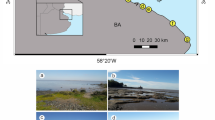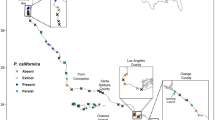Abstract
Here long-term monitoring data taken at 33 sites in southern and central California coast and islands were used to evaluate the size structure of the large intertidal limpet, Lottia gigantea in restricted-access and in easily accessible intertidal zones that encompass a wide range of ecological variables. Using multi-dimensional analysis of population size structures, we found that sites on islands and strictly protected mainland sites have significantly larger median limpet sizes and a greater range of limpet sizes than unprotected mainland sites, while no pattern occurs in latitudinal or regional comparison of sites. Although intertidal predators such as oystercatchers were not the primary focus of the monitoring efforts, extensive natural history notes taken during sampling visits support the argument that predation was not a primary cause for the size structure differences. Finally, substratum differences were determined not to have biased the observation of larger limpets in protected sites. In regard to human interactions with limpets, we conclude that the degree of enforcement against poaching is the better predictor of limpet size structure than proximity to population centers or visitation to intertidal sites.





Similar content being viewed by others
References
Ambrose RF, Smith J (2005) Restoring rocky intertidal habitats in Santa Monica Bay. Santa Monica Bay Restoration Commission, Los Angeles
Berkeley SA, Hixon MA, Larson RJ, Love MS (2004) Fisheries sustainability via protection of age structure and spatial distribution of fish populations. Fisheries 29:23–32
Blanchette CA, Miner BG, Gaines SD (2002) Geographic variability in form, size and survival of Egregia menziesii around point conception, California. Mar Ecol Prog Ser 239:69–82
Bosman AL, Hockey PAR (1986) Seabird guano as a determinant of rocky intertidal community structure. Mar Ecol Prog Ser 32:247–257
Branch GM, Odendaal F (2003) The effects of marine protected areas on the population dynamics of a South African limpet, Cymbula oculus, relative to the influence of wave action. Biol Conserv 114:255–269
Castilla JC (1999) Coastal marine communities: trends and perspectives from human-exclusion experiments. Trends Ecol Evol 14:280–283
Catterall CP, Poiner IR (1987) The potential impact of human gathering on shellfish populations, with reference to some NE Australian intertidal flats. Oikos 50:114–122
Clarke KR, Green RH (1988) Statistical design and analysis for a ‘biological effects’ study. Mar Ecol Prog Ser 46:213–226
Clarke KR, Warwick RM (2001) Change in marine communities: an approach to statistical analysis and interpretation. Primer-E, Plymouth
Cowen RK (1985) Large scale pattern of recruitment by the labrid, Semicossyphus pulcher: causes and implications. J Mar Res 43:719–742
Dawson MN (2001) Phylogeography in coastal marine animals: a solution from California? J Biogeogr 28:723–736
Dayton PK, Tegner MJ, Edwards PB, Riser KL (1998) Sliding baselines, ghosts, and reduced expectations in kelp forest communities. Ecol Appl 8:309–322
Doyle RF (1985) Biogeographical studies of rocky shores near Point Conception, California
Duran LR, Castilla JC (1989) Variation and persistence of the middle rocky intertidal community of central Chile, with and without human harvesting. Mar Biol 103:555–562
Engle JM, Davis GE (2000) Ecological condition and public use of the Cabrillo National Monument intertidal zone 1990–1995. USGS, Sacramento
Francis RC, Hare SR (1994) Decadal-scale regime shifts in the large marine ecosystems of the North-east Pacific: a case for historical science. Fish Oceanogr 3:279–291
Gaston KJ, Tim MB (2000) Pattern and process in macroecology. Blackwell, Oxford
Guerra-Garcia JM, Corzo J, Espinosa F, Garcia-Gomez JC (2004) Assessing habitat use of the endangered marine mollusc Patella ferruginea (Gastropoda, Patellidae) in northern Africa: preliminary results and implications for conservation. Biol Conserv 116:319–326
Haedrich RL, Barnes SM (1997) Changes over time of the size structure in an exploited shelf fish community. Fish Res 31:229–239
Hockey PAR, Bosman AL (1986) Man as an intertidal predator in Transkei: disturbance, community convergence and management of a natural food resource. Oikos 46:3–14
Hockey PAR, Branch GM (1984) Oystercatchers and limpets: impact and implications a preliminary assessment. Ardea 72:199–206
Jackson JBC (2001) What was natural in the coastal oceans? Proc Natl Acad Sci 98:5411–5418
Keough MJ, Quinn GP, King A (1993) Correlations between human collecting and intertidal mollusc populations on rocky shores. Conserv Biol 7:378–390
Kido JS, Murray SN (2003) Variation in owl limpet Lottia gigantea population structure, growth rates, and gonadal production on southern California rocky shores. Mar Ecol Prog Ser 257:111–124
Kingsford MJ, Underwood AJ, Kennely SJ (1991) Humans as predators on rocky reefs in New South Wales, Australia. Mar Ecol Prog Ser 72:1–14
Lasiak T (1993) Temporal and spatial variations in exploited and non-exploited populations of the intertidal limpet Cellana capensis. J Molluscan Stud 59:295–307
Lewis JR, Bowman RS, Kendall MA, Williamson P (1982) Some geographical components in population dynamics: possibilities and realities in some littoral species. Neth J Sea Res 16:18–28
Lindberg DR, Estes JA, Warheit KI (1998) Human influences on trophic cascades along rocky shores. Ecol Appl 8:880–890
Lindberg DR, Warheit KI, Estes JA (1987) Prey preference and seasonal predation by oystercatchers on limpets at San Nicolas Island, California, USA. Mar Ecol Prog Ser 39:105–113
Lindberg DR, Wright WG (1985) Patterns of sex change of the protandric Patellacean limpet Lottia gigantea (Mollusca: Gastropoda). Veliger 27:261–265
Mannino MA, Thomas KD (2002) Depletion of a resource? The impact of prehistoric human foraging on intertidal mollusc communities and its significance for human settlement, mobility and dispersal. World Archaeol 33:452–474
McGowan JA, Cayan DR, Dorman LM (1998) Climate–ocean variability and ecosystem response in the Northeast Pacific. Science 281:210–217
Moreno CA (2001) Community patterns generated by human harvesting on Chilean shores: a review. Aquat Conserv Mar Freshw Ecosyst 11:19–30
Morris RH, Abbott DP, Haderlie EC (1980) Intertidal invertebrates of California. Stanford University Press, Stanford
Murray SN, Denis TG, Kido JS, Smith JR (1999) Human visitation and the frequency and potential effects of collecting on rocky intertidal populations in Southern California marine reserves. CalCOFI Rep 40:100–105
Murray SN, Littler M, Abbott I (1980) Biogeography of the California marine algae with emphasis on the southern California islands. In: Power DM (ed) The California islands: proceedings of a multidisciplinary symposium. Santa Barbara Museum of Natural History, Santa Barbara, pp 325–339
Murray SN, Littler MM (1981) Biogeographical analysis of intertidal macrophyte floras of southern California. J Biogeogr 8:339–351
Oliva D, Castilla JC (1986) The effect of human exclusion on the population structure of key-hole limpets Fissurella crassa and F. limbata on the coast of central Chile. Mar Ecol 7:201–217
Ortega S (1987) The effect of human predation on the size distribution of Siphonaria gigas (Mollusca: Pulmonata) on the Pacific coast of Costa Rica. Veliger 29:251–255
Pacheco MAW, Henderson A (1996) Testing association between species abundance and a continuous variable with Kolmogorov–Smirnov statistics. Vegetatio 124:95–99
Palumbi S (2004) Why mothers matter. Nature 430:621–622
Pombo OA, Escofet A (1996) Effect of exploitation on the limpet Lottia gigantea: a field study in Baja California (Mexico) and California (USA). Pac Sci 50:393–403
Rochet M-J, Trenkel VM (2003) Which community indicators can measure the impact of fishing? A review and proposals. Can J Fish Aquat Sci 60:86–99
Roy K, Collins AG, Becker BJ, Begovic E, Engle JM (2003) Anthropogenic impacts and historical decline in body size of rocky intertidal gastropods in southern California. Ecol Lett 6:205–211
Sagarin R (2001) Historical studies of species responses to climate change: promises and pitfalls. In: Schneider S, Root T (eds) Wildlife responses to climate change. Island Press, Washington, D.C., pp 127–164
Sagarin RD, Barry JP, Gilman SE, Baxter CH (1999) Climate related changes in an intertidal community over short and long time scales. Ecol Monogr 69:465–490
Sanford E (1999) Regulation of keystone predation by small changes in ocean temperature. Science 283:2095–2097
Seapy RR, Littler MM (1982) Population and species diversity fluctuations in a rocky intertidal community relative to severe aerial exposure and sediment burial. Mar Biol 71:87–96
Sharpe AK, Keough MJ (1998) An investigation of the indirect effects of intertidal shellfish collection. J Exp Mar Biol Ecol 223:19–38
Siegfried WR, Hockey PAR, Crowe AA (1985) Exploitation and conservation of brown mussel stocks by coastal people of Transkei. Environ Conserv 12:303–307
Stimson J (1970) Territorial behavior of the owl limpet, Lottia gigantea. Ecology 51:113–118
Tenera E (2003) A comparative intertidal study and user survey, Point Pinos, California. Tenera Environmental, San Luis Obispo
Thompson RC, Crowe TP, Hawkins SJ (2002) Rocky intertidal communities: past environmental changes, present status and predictions for the next 25 years. Environ Conserv 29:168–191
Wares JP, Gaines SD, Cunningham CW (2001) A comparative study of asymmetric migration events across a marine biogeographic boundary. Evolution 55:295–306
Welch DW, Ishida Y, Nagasawa K (1998) Thermal limits and ocean migrations of sockeye salmon (Oncorhynchus nerka): long-term consequences of global warming. Can J Fish Aquat Sci 55:937–948
Wright WG, Lindberg DR (1982) Direct observation of sex change in the Patellacean limpet Lottia gigantea. J Mar Biol Assoc UK 62:737–738
Zacherl D, Gaines SD, Lonhart SI (2003) The limits to biogeographical distributions: insights from the northward range extension of the marine snail, Kelletia kelletii (Forbes, 1852). J Biogeogr 30:913–924
Zedler JB (1978) Public use effects in the Cabrillo National Monument intertidal zone. U.S. National Park Service, Cabrillo National Monument, Point Loma, San Diego
Acknowledgments
Research by MARINe was sponsored by the U.S. Minerals Management Service (Pacific OCS Region), U.S. National Park Service, U.S. Navy, California Coastal Commission, San Diego Association of Governments and County of Santa Barbara. We thank MMS employees M.E. Dunaway, M. Hill, M. Pierson, A. Bull, F. Piltz, and D. Panzer for their help with data collection. We also thank our non-author technicians and many volunteers who helped collect data. This work was performed in part at the University of California Natural Reserve System, Santa Cruz Island Reserve on property owned and managed by The Nature Conservancy. We are grateful to Cojo-Bixby & Hollister Ranches, Vandenberg Air Force Base, Fort Rosecrans Military Reservation, and the Hearst Corporation for access to sites. Map was created using Online Map Creation interface by Martin Weinelt (http://www.aquarius.geomar.de). All work described here complies with current laws of the United States of America. This is contribution number 212 from PISCO, the Partnership for Interdisciplinary Studies of Coastal Oceans: a long-term Ecological Consortium funded by the David and Lucile Packard Foundation and the Gordon and Betty Moore Foundation
Author information
Authors and Affiliations
Corresponding author
Additional information
Communicated by P. W. Sammarco, Chauvin
Rights and permissions
About this article
Cite this article
Sagarin, R.D., Ambrose, R.F., Becker, B.J. et al. Ecological impacts on the limpet Lottia gigantea populations: human pressure over a broad scale on island and mainland intertidal zones. Mar Biol 150, 399–413 (2007). https://doi.org/10.1007/s00227-006-0341-1
Received:
Accepted:
Published:
Issue Date:
DOI: https://doi.org/10.1007/s00227-006-0341-1




